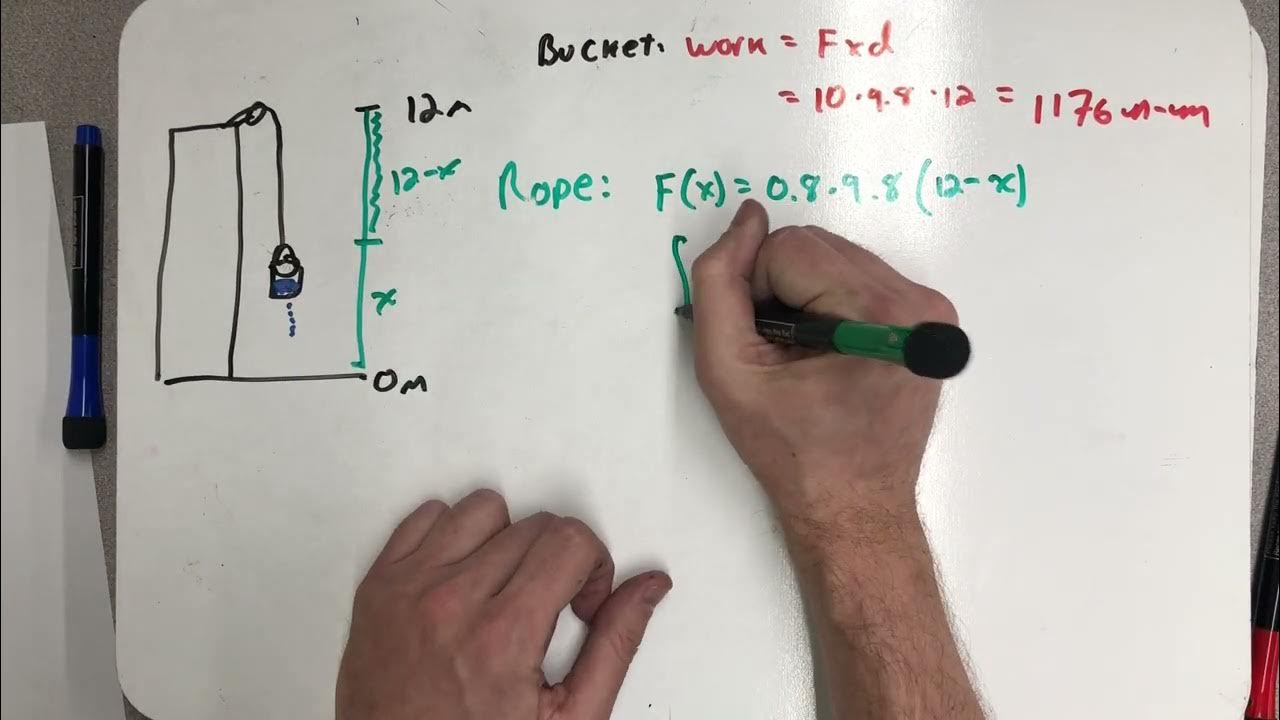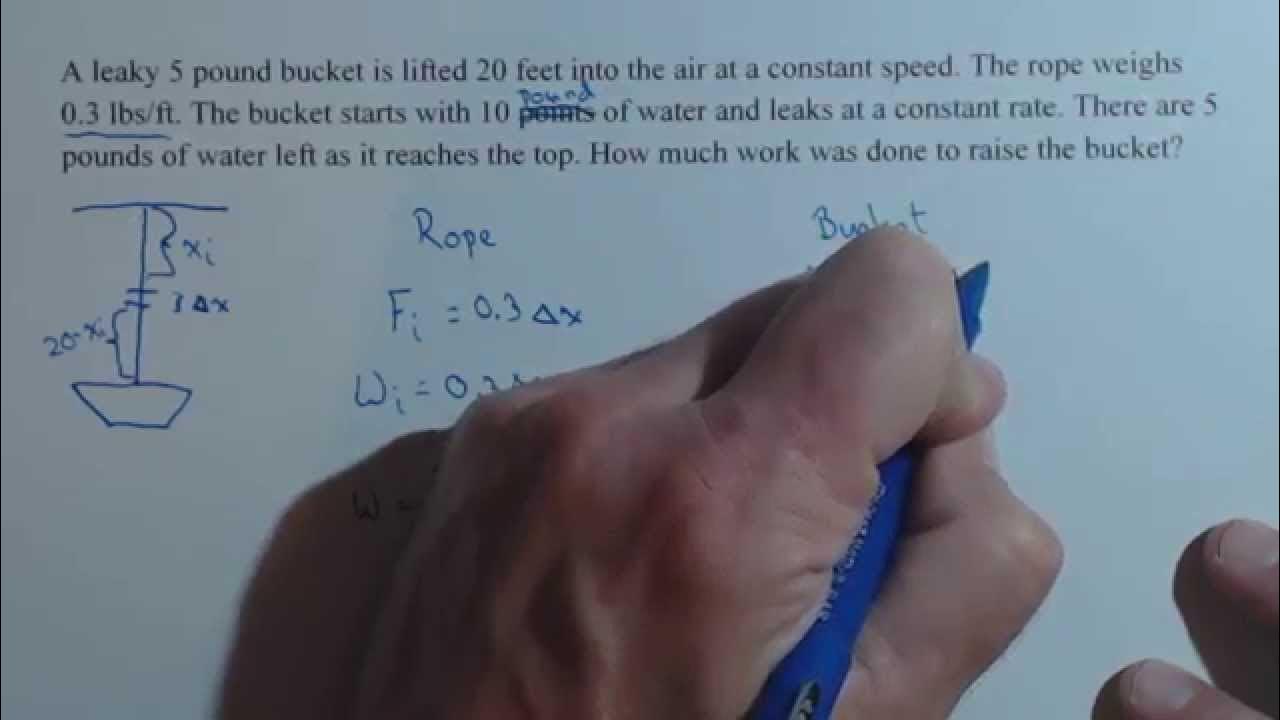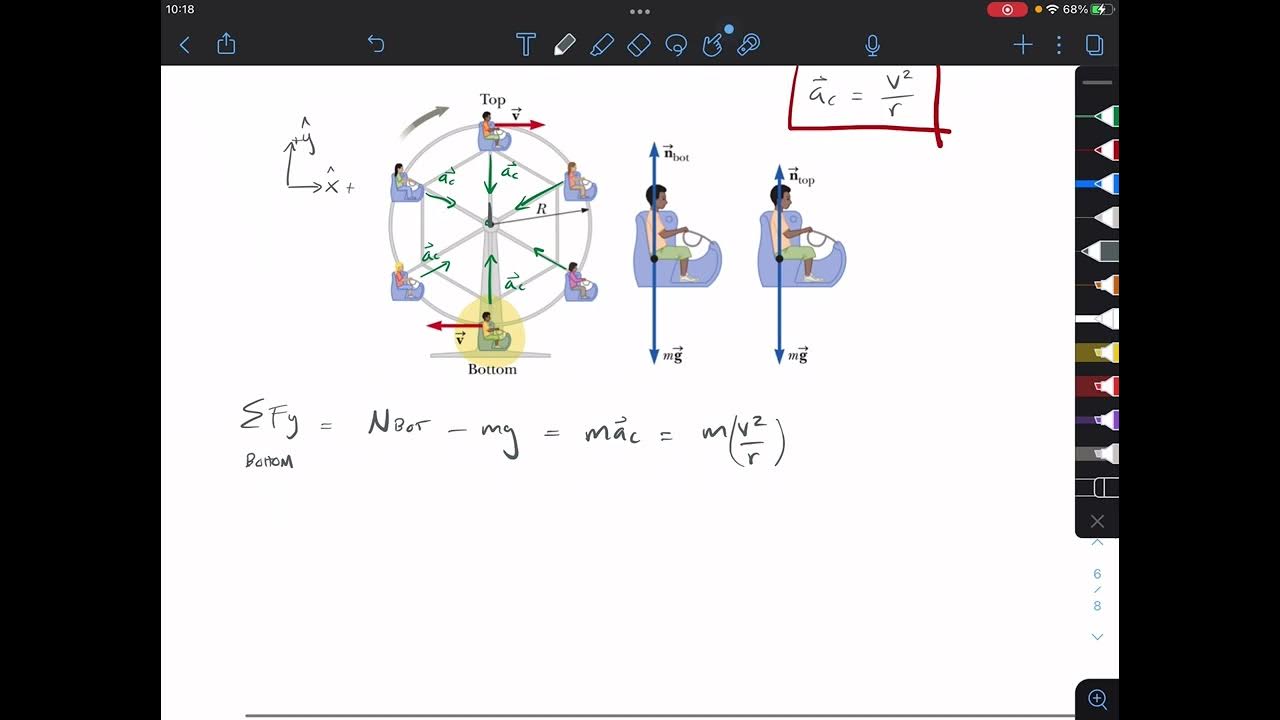Work to lift a leaking bucket
TLDRThe script discusses a physics problem involving a bucket with a variable mass due to a leak, complicating the work calculation. An 8-meter tall building, a negligible weight rope, and a bucket starting at 10 kg are described. As the bucket is lifted, it loses 0.5 kg for each meter, affecting the force exerted by gravity. The challenge is to calculate the work done by integrating the force over the distance, considering the changing mass from the bottom to the top of the building.
Takeaways
- 🏢 The problem involves a building that is 8 meters tall and a bucket that starts with a mass of 10 kg.
- 🪢 The rope's weight is negligible and not considered in the problem.
- 🕳 The bucket has a hole and leaks 0.5 kg of material for each meter it is lifted.
- 📉 As the bucket is lifted, its mass decreases due to the leaking material.
- 🔢 The initial mass of the bucket is 10 kg, and it decreases linearly as it is lifted, reaching 6 kg at the top.
- 🧲 Gravity is a factor in the problem, and the force acting on the bucket is the product of gravity and the bucket's mass.
- 📈 The force acting on the bucket is not constant due to the changing mass as it is lifted.
- 📚 A variable 'x' is introduced to represent the height the bucket has been lifted in meters.
- 🔍 The remaining mass of the bucket at any height 'x' is calculated by subtracting the mass lost due to leakage from the initial mass.
- 📝 The work done in lifting the bucket for a small distance 'dx' is the product of the force at that height and 'dx'.
- 🧩 The total work done in lifting the bucket to the top of the building is found by integrating the work done for each small movement from the bottom to the top.
- ∫ The integration is performed over the range from 0 to 8 meters, representing the entire height of the building.
Q & A
What is the height of the building mentioned in the script?
-The building is 8 meters tall.
Why is the weight of the rope considered negligible in this problem?
-The weight of the rope is considered negligible because the problem focuses on the mass and force changes of the bucket, not the rope.
What is the initial mass of the bucket with the sand?
-The bucket starts with a mass of 10 kilograms.
How much mass does the bucket lose for every meter it is lifted?
-The bucket loses 0.5 kilograms of sand for each meter it is lifted.
What is the final mass of the bucket when it reaches the top of the building?
-By the time the bucket reaches the top, it will have lost 4 kilograms of sand, leaving it with 6 kilograms of mass.
What force is acting on the bucket as it is lifted?
-Gravity is the force acting on the bucket as it is lifted, and it is dependent on the mass of the bucket.
How is the force on the bucket changing as it is lifted?
-The force on the bucket is changing because the mass of the bucket is decreasing as it loses sand, making the force dependent on the height it has been lifted.
What variable is introduced to represent the distance the bucket has been lifted?
-The variable 'x' is introduced to represent the distance the bucket has been lifted in meters.
What is the formula for calculating the remaining mass of the bucket after it has been lifted x meters?
-The remaining mass is calculated by starting at 10 kg and subtracting 0.5 kg for each meter lifted, which is represented as 10 - (0.5 * x) kg.
Why is the work done on the bucket broken up into tiny movements?
-The work is broken up into tiny movements because the force on the bucket is not constant, and it allows for the calculation of work over small distances where the force can be considered essentially constant.
How is the total work done on the bucket calculated?
-The total work done on the bucket is calculated by integrating the work done over all the tiny movements from the bottom to the top of the building, which is represented by integrating from 0 to 8 meters.
Outlines
🏗️ Calculating Work with Variable Mass
The paragraph introduces a physics problem involving a variable mass scenario where the force exerted is not constant. An 8-meter tall building with a bucket attached to a rope is described. Initially, the bucket weighs 10 kg but has a hole causing it to lose 0.5 kg of sand for every meter it is lifted. This results in a decreasing force due to gravity as the bucket ascends. The concept of integrating small movements (dx) to calculate the total work done in lifting the bucket from the bottom to the top of the building is introduced, emphasizing the need to consider the variable mass over the distance.
Mindmap
Keywords
💡work problems
💡mass
💡force
💡gravity
💡variable
💡leak
💡integration
💡tiny movements
💡remaining mass
💡distance
💡current force
Highlights
The problem involves a scenario where the mass or force of an object is not constant, complicating the work calculation.
An 8-meter tall building is used as the context for the problem.
A rope with negligible weight is involved in the problem setup.
A bucket with an initial mass of 10 kg is at the bottom of the building.
The bucket has a hole causing it to leak 0.5 kg of sand for each meter lifted.
The force exerted on the bucket changes as it is lifted due to the loss of mass.
Gravity and mass are considered to calculate the force acting on the bucket.
A variable 'x' is introduced to represent the distance the bucket has been lifted.
The remaining mass of the bucket is calculated based on the distance lifted.
The force acting on the bucket is the product of gravity and the remaining mass.
The work done on the bucket is considered in small increments as it is lifted.
The work for a small movement is calculated using the current force and the distance moved.
The total work is obtained by integrating the work done over all small movements from the bottom to the top of the building.
Integration is used to sum up the work done over the entire lifting process.
The integration process considers the variable force due to the changing mass of the bucket.
Transcripts
Browse More Related Video

Leaky Bucket

Work Done Raising a Leaky Bucket with an Integral

Work done on lifting/falling things - Solved numerical | Work & Energy | Physics | Khan Academy

Pumping water out of a bucket, calculating work, calculus 2 tutorial

Uniform Circular Motion - 3 - Ferris Wheel

Treating systems (the hard way) | Forces and Newton's laws of motion | Physics | Khan Academy
5.0 / 5 (0 votes)
Thanks for rating: